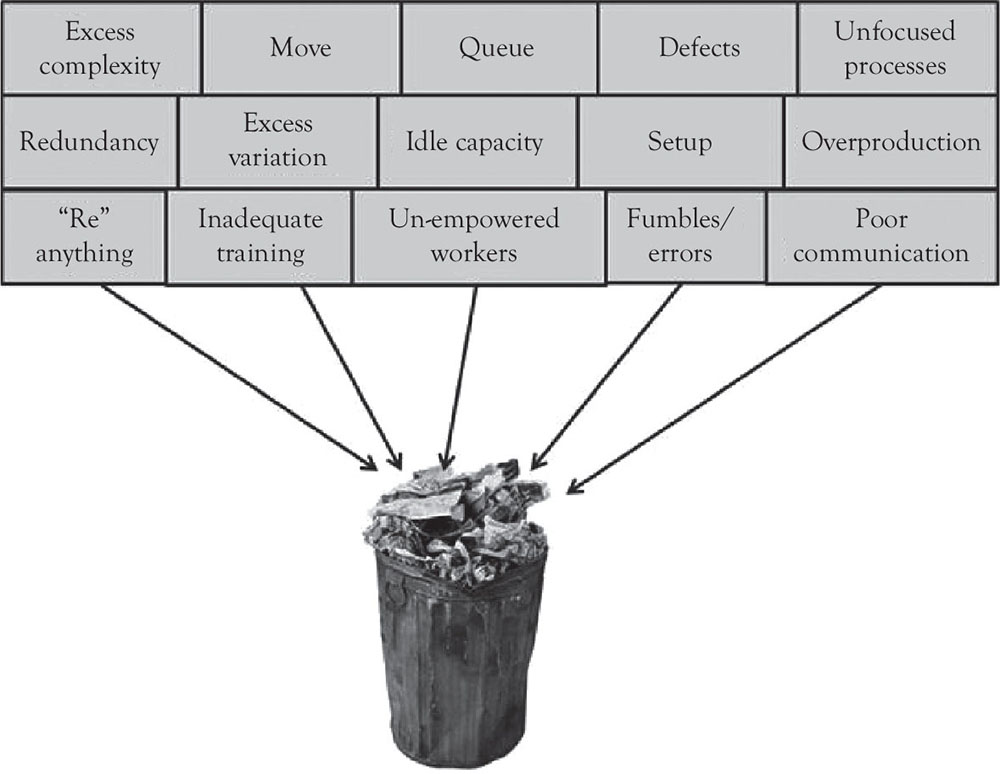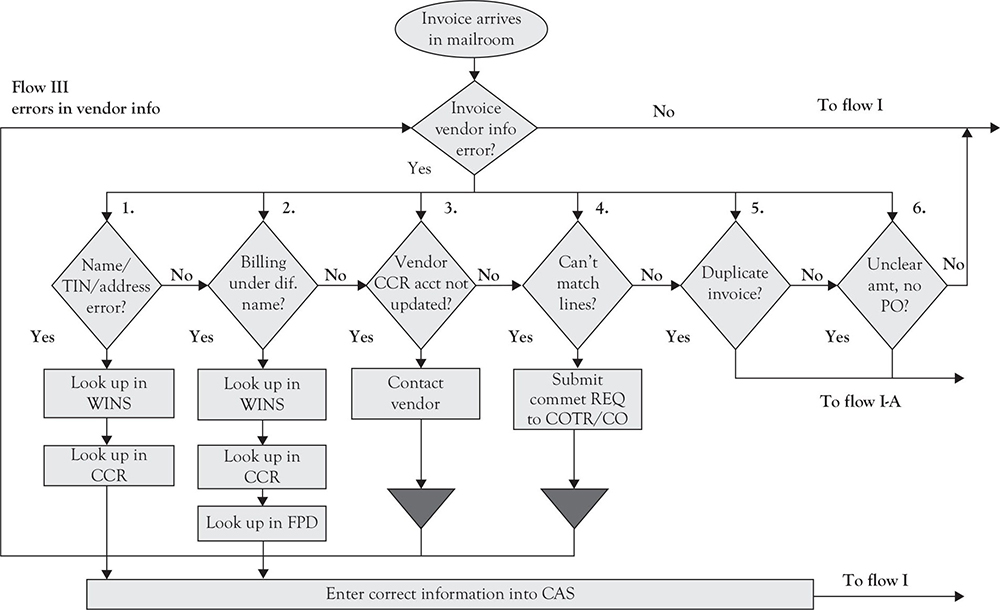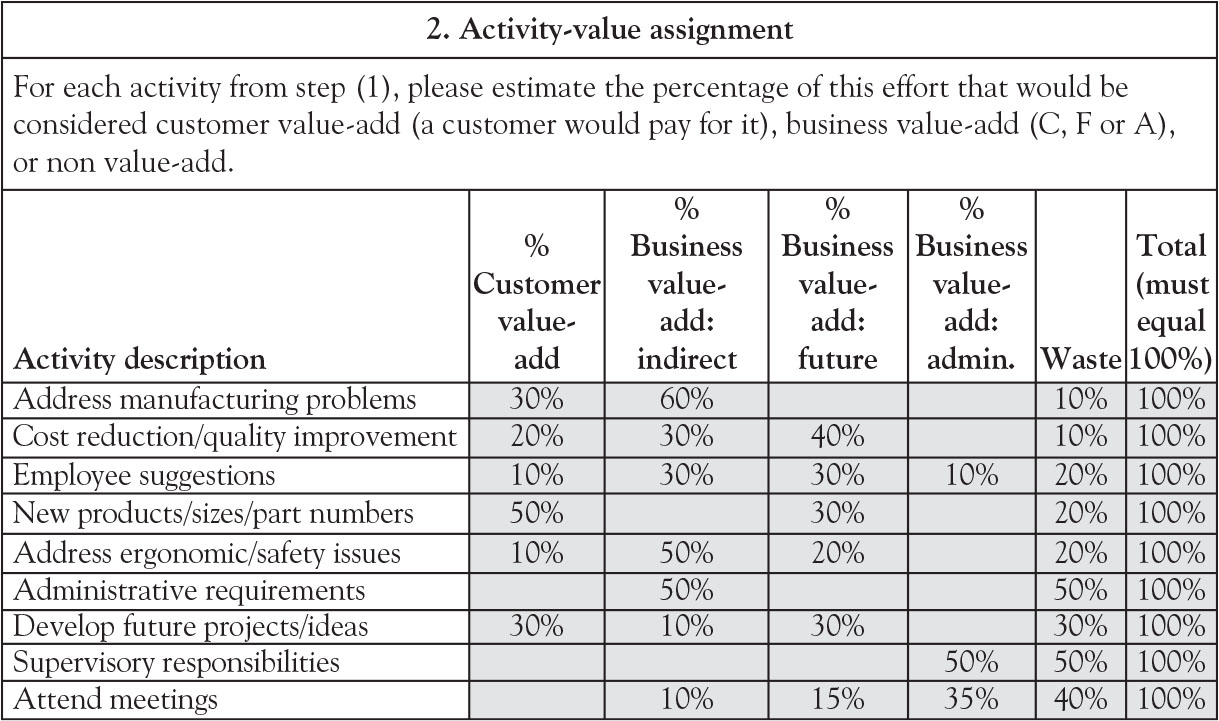A Focus on Waste: Eliminating Nonvalue-Added Activities
A man cannot be paid much for producing something which is wasted.
Henry Ford1
Waste is something that no human being enjoys creating. To waste resources is to potentially create a resource shortage in the future. To do work that is deemed to be wasteful is demoralizing. Waste destroys profit and current and future opportunities to create value. A company has to recognize, measure, and eliminate waste if it is to achieve its profit potential.2 Waste occurs throughout the organization, in every activity and every function. The goal in measuring waste is to make it visible so it can be eliminated.
The Many Faces of Waste
Waste is an insidious part of every organizational activity. Every time someone has to repeat an action or undo something another person has done, waste occurs. When workers are left idle because of poor scheduling, waste occurs. And as Henry Ford suggested in the opening quote, it is difficult to pay someone for creating waste.
Figure 4.1 provides a list of many ways in which waste is created in organizations. As we saw in the Easy Air example in Chapter 3, waste can also be embedded at the task or action level. Waste occurs when there is miscommunication, so that a task is “fumbled” as it passes from one work station to another. When too much value is added to a product, waste is created. Much of the paperwork that consumes so much of the BVAA activities in a firm is waste. So, what are the various faces of waste?

Figure 4.1. The many faces of waste.
Note that waste drops directly into a garbage can in this figure. Waste is the garbage of the organization, collecting in activity after activity. Since waste comes directly out of profit, it destroys the value of the firm. It is spending that never benefits anyone—it simply robs the profit potential of the firm.
One of the easiest ways to spot waste is to follow a piece of paper, perhaps an order to be produced, through an organization. What is seen is that waste starts to accumulate as soon as the order is launched. It can be in such simple things as the order entry activity. Let’s say the order is taken by customer service clerks, who fill out all the required forms (physical waste) and then staple them together in the order they were trained to use. The order is then walked down the hall to order entry (move, a waste factor) where it is placed in the order entry clerk’s in basket (queue, some more waste). Once the order entry clerk picks up the packet, it is immediately unstapled because the sheets are not in the order that the computer screens require (undo, redo, waste). The clerk then enters the information into the system and it moves on to production scheduling.
Waste would be eliminated here if the customer service representative directly entered the order detail into the computer while talking with the customer. An order receipt could be generated immediately and e-mailed to the customer, providing a touch point and getting an early lead on potential order entry errors. Waste is converted in this way into a value-add activity, namely service responsiveness. The savings can be used to further improve order entry functions or to add to the firm’s value-added core. The former will potentially reduce BVAA, which means improved profitability. The latter will promote a cycle of growth for the company. Either way, getting the waste out is essential to today’s and tomorrow’s profitability.
The Lean Model and VCMS
The lean management model has an overriding goal—to identify and eliminate waste from the organization wherever it occurs through a process of continuous improvement. Using process analysis techniques, teams map out the workflow for various outputs and use mapping graphics to identify the primary sources of waste. This value stream mapping documents and then directs the transformation to a lean enterprise. In discussing value stream mapping, Keyte and Locher note the following:3
Though value stream mapping can identify continued opportunities to enhance value, eliminate waste, and improve flow, it is not the end, but the beginning of the journey in value stream management. In Deming terms, it is the “P” in the PDCA cycle (plan-do-check-act) … It allows a company to document, measure, and analyze a complex set of relationships as well as to plot a course to create an improved operating strategy and organizational design.
Value stream mapping can be done in both productive and support areas of the firm. At one site, the U.S. Coast Guard Finance Center (FINCEN), the accounts payable function was analyzed to identify ways to streamline the process so the organization could take greater advantage of prompt payment discounts offered by their vendors. One of the value stream maps created during this exercise is shown in Figure 4.2.

Figure 4.2. A value stream map.
As can be seen, there were a large number of sources of error in entering vendor information. This led to delayed payments and loss of the prompt payment discount. The operation to enter vendor information was also overly complex, with the accounts payable individual having to access three major databases to complete the data entry task. Every one of the diamonds in Figure 4.2 represents waste, as does the tasks taken to remediate an error in the vendor information. This was an entire flow of wasted activities, one that cost the Coast Guard significant amount of resources and benefits.
The flow was fixed using a combination of lean and VCMS techniques. Within the first six weeks after the process was improved, the Coast Guard saw a $1 million increase in the amount of purchase discounts taken. This money was immediately put to use to provide the Coast Guard fleet with more fuel and resources to expand their mission base, a direct creation of more value for the country.
Waste in Every Activity
What we saw in Easy Air’s charts was the fact that many activities have some level of waste in them. When collecting this information, employees are often hesitant to insert any waste into their responses, fearing management repercussions. But, huge improvements identified with lean management would not exist if there was not waste in every activity. The goal has to be to constantly work with the information providers so that they become more comfortable with identifying the “re’s” existing in most processes.
Let’s look at an activity grid from Windows, Inc. to see an example of the kind of waste that is embedded in their processes (see Figure 4.3). As you can see, every activity is noted to have some level of waste in it. Administrative reporting is perceived as 50% waste, while even 20% of the value-adding activity of supporting the development of new products is perceived as waste. This manager was very honest, probably due to the fact that he worked in product quality management function and was familiar with how this information would be deployed. In collecting this type of information employees need to understand the purpose for collecting the information and the way that this information will be used.

Figure 4.3. Windows, Inc. waste reporting.
We can also tell something about the individual who prepared the report shown here. He clearly doesn’t think much of spending his time in meetings or meeting administrative requirements. He even puts 50% waste on his supervisory responsibilities. This clearly is someone who prefers action to talking about work. That’s a good fit for someone in the quality area, as is the honesty and objectivity in reporting about different aspects of his job. The information in Figure 4.3, then, is an ideal state where the individual who responded really understood the purpose of the data collection and reports objectively. It can take several iterations to gain this much trust in an organization. No one likes to admit to waste.
Structural Versus Process-Based Waste
Waste can be embedded in the structure of the organization, as we’ve seen here. A very top-down management structure that requires a lot of paperwork and meetings embeds significant amounts of waste in everyone’s workday. Even if a meeting is productive, there are elements of waste in it. Anyone who has sat through the tedium of one PowerPoint presentation after another knows this fact. Unless a meeting is called to address a specific problem and is expected to yield concrete take-way points, it can waste a significant amount of a firm’s most valuable resource—the time individuals have available to do value-adding work.
What we see in Figure 4.4 is that the structure of the organization can embed waste that constricts the flow of the value-added processes. Structural waste, then, restricts the growth of the total organization. Process-based waste, on the other hand, restricts the total amount of value the organization can create within its structural boundaries.4

Figure 4.4. Structural versus process-based waste.
The way in which a company is structured defines the type and amount of resources it will need to accomplish its work. This structure—the number of plants, divisions, departments, or related subunits the company has as well as where they are located and how they interact—places boundaries around the value creation process. And in the same way that the structure of a garden hose constricts the amount of water that can flow through it, the structure of an organization constrains the amount of work it can do in any defined period of time.
There are three basic ways that waste is built into the structure of an organization. These permanently increase the amount of cost that is incurred when operating the system to deliver goods and services:
• There can be excess capacity in the system in total, or of specific key resources. An example here would be a machine that is “slaved” to a just-in-time cell. No matter what the true capacity of that machine is to do work, it will only be used up to the point required to balance the flow. Significant amounts of the machine’s capacity can be permanently wasted. This is not to say that this “slaving” is always undesirable—it simply needs to be done with a clear understanding of its impact on long-term profitability.
• Inadequate development of the baseline capability of the people that interact within the system. If people are not trained to do a job efficiently and effectively, waste becomes rampant. Training can be a significant waste reducer.
• Unnecessary or excessive complexity in the structure and activities of the value chains that deliver specific goods and services to customers and markets. Simplifying value chains is one of the goals of value chain management. Removing steps in the value chain can remove significant amounts of embedded waste.
Process waste comes from all of the “un’s,” “re’s,” excesses, interruptions, complexity, variation, and add-on activities that constrict the flow through the structural boundaries of the organization—they are kinks in the hose of value creation. Each of these forms of waste reduces the organization’s ability to create value for its customers as they reduce the flow of value creating work. Removing process-based waste allows an organization to reach the profit potential its structure allows.
The Behavioral Impact of Waste
As noted in the opening pages of this chapter, no one likes to do work that ends up being defined as waste. During one visit to a bar soap manufacturer, the impact of waste on employee morale became very visible. Each subsequent bad bar was flung more angrily into the waste bin. Sure, the soap could be reworked, but everyone knew that was not the optimal path. It angers people to see their work tossed away. It is an unusual person who doesn’t prefer the satisfaction of a job well done to one that is deemed to be waste.
There are ways to make waste visible that can alert employees to the status of their efforts. At one refrigerator manufacturer, a “waste” meter was set up that noted at each stage of production what the level of waste was and how that translated into dollars of lost profit. Employees took more care in their work, not wanting to be the one to drive up the waste meter for the day. It also led to some strange behavior at the end of the line, though, as several strong men used rubber mallets to get doors into alignment so they could pass final inspection. While the intent of this activity was laudable, the doors should have been in alignment to start with.
Figure 4.5 suggests a way to think about waste and measure it to reduce its consequences. The key thing is to measure waste to make it visible, also tracking waste so that it is discovered as soon as possible in the work flow. And, as some of the Japanese models suggest, waste can be a primary source of organizational learning. Improvement in how work is done comes from understanding how waste occurs and then developing methods and techniques to eliminate it. In the beginning, there is waste everywhere, but as processes are improved, waste becomes a gem that leads to more improvement efforts. In the pursuit of continuous improvement and Six Sigma quality levels, a company seeks out waste wherever it occurs, in an honest search for ways to eliminate it.

Figure 4.5. Eliminating waste: a framework for action.5
One final comment needs to be made. Employees are not the cause of waste—they are the key to eliminating it. Without employees, dedicated to improving the process, the goals of the organization cannot be reached. Waste elimination, then, helps to bring the organization together with a common purpose—to purge waste from every activity, action and task so that the firm can reach its profit potential.
Summary
In this chapter we’ve talked about the various forms that waste can take in the organization, and noted how important it is to eliminate it wherever it is found. Wasted actions can demoralize the workforce and reduce a firm’s profit potential. The profit potential of a firm’s set of resources is constrained by the structure of its processes and subunits. Highly bureaucratic firms are more prone to waste because of the high level of administrative work that has to be done as well as the embedded delays that take place when decisions and actions have to work their way up the chain of command before they can be undertaken. That is why an empowered workforce is so important—it helps to stop waste at the point of action, reducing its total impact on the organization.
It’s important to find ways to make waste visible so that it can be acted upon. While employees are often hesitant to admit to the presence of waste in their activities, there is waste everywhere. Making employees comfortable with the fact that identifying waste is actually an opportunity to improve performance rather than the source of punishment is a critical step in making the VCMS a reliable basis for taking action. If everyone begins to see waste as a gem that leads to continuous improvement and learning, it becomes much easier to get this information from them.
Waste takes many forms, including excess capacity, “re’s,” “un’s,” and any number of other sources. Value stream mapping helps identify waste at the task level, but cannot always be undertaken. The VCMS allows managers to pinpoint waste and focus attention on areas deemed to have the most waste. Decisions can then be made whether to expend the resources required to complete a value stream map or to instead use brainstorming or employee expertise to isolate and eliminate the identified waste.
Waste robs an organization of its future value-creating potential. Because the VCMS allows for waste in every activity, it differs from existing activity analysis practices that only isolate entire activities that are waste. Waste takes place at the task or action level, and that is where it needs to be addressed. It is everyone’s job to find and eliminate waste so a firm can reach its profit potential.
In formal logic, a contradiction is a signal of defeat; but in the evolution of real knowledge it marks the first step in progress toward a victory.
Alfred North Whitehead6
